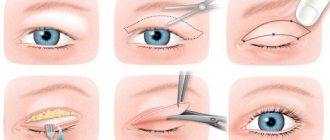Like any surgical procedure, blepharoplasty can have unpleasant consequences. It is imperative to take a responsible approach to choosing a clinic and a plastic surgeon who will perform the operation. However, even these actions do not guarantee a 100% positive result.
During the consultation before the operation, the doctor is obliged to inform the patient about the possible unforeseen consequences of blepharoplasty.
There are 3 common types of claims made by those undergoing surgery:
- Surgical . Development of blepharoptosis, postoperative swelling, eye asymmetry;
- Psychological . In case of unreasonably high expectations from the operation;
- Physiological . Scars, slow healing.
Blepharoplasty: consequences of unsuccessful surgery
Conventionally, complications after surgery can be divided into:
- temporary complications of the early period that do not require repeated intervention and disappear on their own over time;
- complex, the occurrence of which requires repeated surgery or continued treatment.
The first group usually includes hematomas and swelling that occur in the early postoperative period. Such consequences are caused by injury to small vessels as a result of dissection of soft tissue. Hematomas will go away on their own; if you apply cold compresses, recovery will speed up.
Important! The presence of bruises may indicate that large vessels were hit. This condition requires immediate surgical intervention.
Swelling occurs after almost any blepharoplasty. Bags under the eyes, in most cases, disappear within a week, however, sometimes the recovery period can take up to three months.
In some cases, after blepharoplasty, tearing occurs. As a last resort, if it is impossible to correct the problem locally, probing of the lacrimal canal can be used.
It is possible to develop allergic reactions to the administered drugs and dressings. If necessary, the attending doctor prescribes antihistamines.
Problems after unsuccessful blepharoplasty of the upper and lower eyelids
After an unsuccessful operation, the following complications may occur:
- Seam divergence;
- Drooping of the upper eyelid;
- Eversion of the lower eyelid;
- Asymmetrical eyes.
The most common consequences of unsuccessful upper blepharoplasty:
- inversion of the upper eyelid;
- eye asymmetry;
- hematomas and swelling;
- retrobulbar and subcutaneous hematomas.
After lower blepharoplasty, the following are possible:
- drooping eyelid;
- swelling;
- asymmetry;
- eversion of the eyelid;
- divergence of seams.
All the consequences of unsuccessful operations described above necessarily require a repeat operation. The faster the consequences are corrected, the sooner you will achieve the desired result.
Lagophthalmos as a complication after surgery
This is the name for a violation of the process of closing the eyelid. This complication as a result of unsuccessful blepharoplasty surgery is clearly visible in the photo.
This defect is caused by the removal of excessive amounts of skin during surgery. The problem may also arise if the second operation was performed too quickly after the first.
As a result of lagophthalmos, the process of normal hydration of the cornea is disrupted, which is why it can lose its transparency and even cause blindness in the patient. It is for this reason that it is very important to undergo repeated surgery to correct such a deficiency.
Why might the operation fail?
Unfortunately, the most common reason for a failed operation is insufficient qualifications or mistakes by the surgeon. Therefore, we recommend that you approach the choice of the doctor who will perform the operation as carefully as possible. This must be an experienced surgeon who has had a sufficient number of successful operations in this area. The clinic where blepharoplasty will be performed must have all the necessary modern equipment for eyelid correction.
Remember that proper preparation for surgery and compliance with all doctor’s recommendations is the key to successful correction!
However, you should not place all responsibility for the result of the operation on the plastic surgeon alone. Most complications depend on the individual characteristics of the patient’s body.
Eye asymmetry
Asymmetry can occur as a result of improper sutures by the doctor or due to disruption of the adequate process of tissue scarring. Also, the reason for this result of an unsuccessful blepharoplasty operation, shown in the photo, can be the doctor’s inattention to the already present congenital asymmetry. The operation in this case can enhance the existing effect if it is not taken into account.
Common Complications
Let's take a closer look at the negative consequences of unsuccessful eyelid blepharoplasty:
- Diplopia . This consequence is double vision of the eye, which occurs as a result of trauma to the eye muscles. This problem most often occurs during lower eyelid blepharoplasty. In this case, urgent surgical intervention by an ophthalmologist is necessary.
- Retrobulbar hematoma . Formed as a result of blood clots forming behind the eyeball. A characteristic sign of the formation of pathology is protrusion of the eyeball forward. This is a dangerous situation for the patient and requires immediate surgery, otherwise vision loss is possible.
- Blepharoptosis . A disease characterized by drooping of the upper eyelid. Most often it occurs in one eye. The most common problem among older patients. Blepharoptosis occurs due to damage to the muscles of the eye and requires surgical intervention.
- Decreased and complete loss of vision . Unfortunately, no patient is immune from such an outcome. In most cases, the problem occurs as a result of large swelling; hemorrhages in the orbit are not excluded. If you feel something is wrong with your vision, immediately consult a doctor to take the necessary measures, this will help preserve your vision.
- Ectropion of the eye . It is an eversion and retraction of the eyelid. The problem can affect both the upper and lower eyelids. Cases of ectropion of both eyelids have been reported. If the situation is minor, you can get by with a simple massage. However, in most cases, repeat surgery will be required. Only your attending physician can assess the degree of complexity of the situation.
- Inflammation of the eye membranes and non-closure of the eyelids. Such complications most often arise as a result of violation of sanitary and hygienic standards during surgery or during the rehabilitation period. If you strictly follow all the doctor’s recommendations, the problem will be solved in a short time. Eyelid closure will become normal after three weeks after blepharoplasty. In this case, you can do without repeated surgery.
- Dry eye syndrome . This is one of the most common consequences of blepharoplasty. The doctor will select the right drug for you to help get rid of the discomfort.
Methods for correction of the periorbital zone
Modern aesthetic medicine offers various techniques for solving individual problems or complex rejuvenation and correction of the eye area. Depending on individual indications, anatomical features and wishes of the patient, Damas Clinic doctors recommend effective and safe techniques.
- Classic blepharoplasty is aimed at aesthetic rejuvenation.
Indicated for excess thinning skin, fatty hernias, and age-related ptosis of the upper eyelids. During the procedure, access is formed at the border of the moving and fixed zones. As a result, the scar is completely hidden in a natural skin fold and is completely invisible. The doctor performs resection of fatty hernias and excess skin, returning the original eye contour and youthful look.
- Complex surgery allows you to simultaneously eliminate age-related changes and correct asymmetry caused by congenital pathologies, injuries, surgical interventions or other factors.
The doctor eliminates the reasons that disturb the harmony of the face and makes the look attractive.
- Europeanization of Asian upper eyelids involves the formation or strengthening of a natural fold, eliminating excess volume in the periorbital area.
During the operation, the doctor excises a spindle-shaped flap of skin and a strip of muscle 2-3 mm wide, modeling the desired incision and shape of the eyes.
- Canthopexy can be performed separately or in combination with classical rejuvenation surgery.
The procedure is aimed at changing the shape and shape of the eyes from Oriental to European or vice versa by tightening the outer and inner corners.
Non-surgical blepharoplasty
If your situation is not life-threatening, and the fear of complications is too great, it is worth considering methods of performing blepharoplasty without surgery. Here are the main ones:
- thermage;
- hardware;
- injection
- sms-lifting;
- thermolifting
Of course, these methods also have their drawbacks, but they are much less than those of operating procedures. One of the main disadvantages is the presence of swelling for some time after the operation. However, this lasts no more than a week.
Advantages of blepharoplasty without surgery:
- safety of the method;
- targeted impact on the desired area;
- low trauma;
- no pain during the procedure;
- quickly get the desired result
If you decide to undergo non-surgical blepharoplasty, remember that several procedures are necessary to obtain the desired result.
How to prevent an unsuccessful outcome?
The natural desire of the patient before undergoing surgery is to be able to insure against complications after the procedure. Therefore, we strongly recommend that you carefully consider the preparation of the operation and calculate all possible troubles. Most of the possible problems can be prevented; all you need to do is choose the right clinic and plastic surgeon.
Choosing the right doctor
The main task is to choose a surgeon who is a specialist in the area you need. With the right choice, the possibility of a negative outcome from the operation will be reduced to zero. A doctor with extensive experience and status simply cannot afford to make a mistake, and performs all his actions impeccably and with the utmost care. An experienced surgeon can calculate in advance all possible unpleasant consequences and will do everything to prevent this.
Important! If blepharoplasty is performed incorrectly, it will be impossible to completely eliminate errors. It is realistic to only correct the errors as much as possible during a repeat operation.
Anything associated with surgery in the eye area is surrounded by significant risks due to the fragility of eye tissue. In some cases, the problems may resolve on their own, but for the most part, repeat blepharoplasty will be necessary.
The importance of following recommendations
Immediately after blepharoplasty, the patient is sent to the ward, and a cooled bandage is applied to the eyes to reduce swelling and relieve pain. In the postoperative period, it is most important to strictly follow the recommendations of the attending physician, since the operation is accompanied by certain changes in the condition.
The patient must remain in bed for 24 hours after blepharoplasty. You can only lie on the back of your head to avoid injury and reduce swelling.
After the operation, you must follow these recommendations:
- use any medications only under the supervision of a doctor;
- temporarily avoid solid foods and chewing gum;
- do not be in direct sunlight;
- wash your hair for the first time only after consulting a doctor;
- women are allowed to apply makeup only 10 days after blepharoplasty;
- To avoid swelling, minimize the consumption of spicy and salty foods
- stop smoking;
- consultations with a doctor for a year after surgery, following all recommendations.
Remember! Each body is individual, so all prohibitions and recommendations should be discussed with your doctor in more detail.
If you do not follow the above recommendations, you risk reducing your blepharoplasty to zero and causing serious health problems.
How to choose the right medical specialist and clinic
The risk of unsuccessful blepharoplasty results increases if the patient tries to save money on the procedure and chooses a dubious doctor or clinic. It is very important to verify the qualifications of the doctor before you decide to undergo plastic surgery with him.
The services of truly good medical specialists are rarely cheap, so in order to avoid paying twice, it is strongly recommended not to try to save in this case at the expense of beauty and health. Don’t be shy about asking your doctor for a portfolio during a consultation. Experienced surgeons will always tell you where you can see examples of their work and show reviews from their patients.
If a specialist does not inform the patient in advance about possible complications, and also does not require mandatory detailed diagnostics in order to determine contraindications, this should be alarming.
Unsuccessful blepharoplasty (before and after photos allow you to evaluate the results of the operation) is a common occurrence. You can protect yourself from possible unpleasant consequences only by adhering to the above recommendations. Also, do not be lazy to visit your doctor after surgery during the rehabilitation period. This way you can protect yourself and prevent the development of complications due to an unsuccessful operation.
Elimination of consequences
If you still cannot avoid complications after blepharoplasty, you will need a repeat operation. If you trust your doctor and are sure that the consequences are not his fault, you can trust him with the correction. If a doctor makes a mistake during an operation, it is worth looking for another clinic and surgeon. Only a doctor with extensive experience and qualifications will be able to assess the degree of complications and draw up a plan to eliminate them.
In some cases, drug treatment will help, but for more severe complications, surgical intervention is necessary.
Repeated blepharoplasty
You should not be afraid of having a repeat operation; a competent specialist will help correct the situation with minimal losses. Try to collect as much information as possible about surgeons and clinics where they perform blepharoplasty. Look for real reviews on the Internet, on forums or on the website of the clinic itself. A self-respecting clinic will not post false reviews about its specialists.
What is additional correction
In cases where surgery can be avoided, correction will help. This includes physiotherapy, lymphatic drainage or medication.
Remember that the responsibility for the successful outcome of the operation lies with you. It is up to you to find a professional who will perform the operation competently and as accurately as possible. On our website you can get acquainted with clinics that perform blepharoplasty in Moscow and other cities of Russia, study prices, equipment, and a list of surgeons.
Finally, we recommend that you look at photos of patients who have had unsuccessful surgery.










